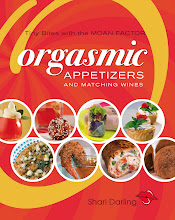 Even though I consider myself an advocate of classic table wines, I sometimes crave cold ale or a glass of chilled, refreshing fruit wine on a hot, summer day. In Ontario we have fruit wines made from locally grown fruits, such as apples, rhubarb, cherries, strawberries, raspberries and blackberries. These wines are produced in a variety of styles, such as dry, sparkling, off dry, sweet and very sweet.
Even though I consider myself an advocate of classic table wines, I sometimes crave cold ale or a glass of chilled, refreshing fruit wine on a hot, summer day. In Ontario we have fruit wines made from locally grown fruits, such as apples, rhubarb, cherries, strawberries, raspberries and blackberries. These wines are produced in a variety of styles, such as dry, sparkling, off dry, sweet and very sweet.Fruit wines can be enjoyed with a variety of dishes, especially entrees containing fresh fruit as an ingredient, such as berry sauces or compotes. These wines are enjoyed in much the same way as classic table wines, that is by using your senses in smelling and tasting them.
The first step to enjoying fruit wine is to look at its colour and clarity. The wine should be bright. Swirl the glass to add air, which helps to carry the aromas to the surface of the glass and therefore up to your nose. Our nose has the ability to distinguish over 10,000 different smells whereas our mouth only has four taste sensations. So, most of the enjoyment of wine can be found in the art of swirling and smelling. Unlike table wines that can magically take on an endless array of aromas, fruit wines should smell like the fruit from which they are made. For example, a good Chardonnay may smell like apples to one person; pears, to another. Another person may insist this same wine smells and tastes of tropical fruit, such as melons. A quality fruit wine made from raspberries should smell like … well, raspberries. A blended fruit wine produced from apples and rhubarb should then smell like
 this same combination of fruit. By the same token, if a raspberry wine does not smell like the fruit of origin, then it is not, necessarily, considered a winner.
this same combination of fruit. By the same token, if a raspberry wine does not smell like the fruit of origin, then it is not, necessarily, considered a winner.The same goes for tasting fruit wine. The wine should taste like the fruit from which it is made. Like classic table wines, fruit wines have building blocks, such as acidity, sweetness, bitterness and sometimes viscosity (weight of mouthfeel) often described as fattiness.
Many fruit wineries produce wines in four sweetness levels, such as dry, off dry, semi sweet and sweet. I personally believe all fruit wines should possess some sweetness to balance their natural acidity. I’m not fond of fruit wines that are vinified dry. Fruit wines are not supposed to compete with dry table wines produced from grapes. In fact, I think vinifying fruit wines to dry gives this genre a bad reputation. Fruit wines will never taste like table wines made from grapes or vice versa. And that’s a good thing. Fruit wines don’t have to compete with table wines, no more than action flicks need to compete with romance movies. There’s a place in our culinary world for both.
Wines fermented from fruits complement a wide array of appetizers, salads, soups, entrees and desserts. Barbecued ravioli with a dollop of raspberry and wasabi mayonnaise is a tasty appetizer to pair with chilled raspberry wine. A salad of fresh greens drizzled in a strawberry vinaigrette works nicely when partnered to strawberry wine. And there’s nothing more refreshing on a hot summer day than a bowl of raspberry gazpacho decorated with fresh mint. Apple cranberry wine is a great match for pork chops with applesauce or pork ribs glazed with brown sugar and dried apples. East Indian and Thai curries taste outstanding when highlighted by a glass of fruit wine possessing balanced sweetness. Just make sure the wine is sweeter than the sweetness in your dish.
Like a chilled ounce of icewine, a sweet fruit wine can stand on its own. It is dessert!
Ontario is home to many awesome fruit wineries.

Kawartha Country Wines, located at 2275 County Road 36 in Buckhorn, is a lovely place to visit for the ambiance, gourmet fare and delicious wines. Here you can sample wines and pick up interesting and unique foods and food and wine related items in their gourmet shop. Owners John Rufa and Trish Dougherty recently won silver medals in the All Canadian Wine Championships for their 2008 Rhubarb, $13.80, and their 2007 Black Current, $14.80. My favourite is their Rasperry Port. It is outstanding. Kawartha Country Wines is hosting a strawberry festival at the winery on June 27, 2009. For more information call
Many other wineries from across the country took home medals in the All Canadian Wine Championships, as well. Double gold medals went to the following:
Soft Fruit Dry
Scotch Block Winery, ON 2008 Regal Black Currant $12.95
Soft Fruit Off-Dry
Muskoka Lakes Winery, ON 2007 Cranberry Blueberry $16.75
Soft Fruit Dessert
Scotch Block Winery, ON 2008 Black Currant Truffle $14.95
Tree Fruit Dry
Verge Belliveau Orchard, NB 2007 Poire $12.99
Tree Fruit Off-Dry
Sunnybrook Farm Estate Winery, ON N/V Golden Plum $19.75
Tree Fruit Dessert
La Face Cachee de la Pomme, PQ 2007 Frimas Ice Cider $39.87
(Trophy, Best Fruit Wine)
**Sponsored by Ontario Viniculture Association
Fruit Fortifieds
Les Vergers de la Colline, PQ 2006 L'Ensorceleuse $23.70
Fruit Sparkling *NEW Category
Cidrerie du Minot, PQ N/V Cremant de Glace $23.90
Meades
Applewood Farm Winery, ON 2008 Mac Meade $12.45
Grape Fortifieds & Other Desserts
L'Acadie Vineyards, NS 2008 Soleil $29.38




















